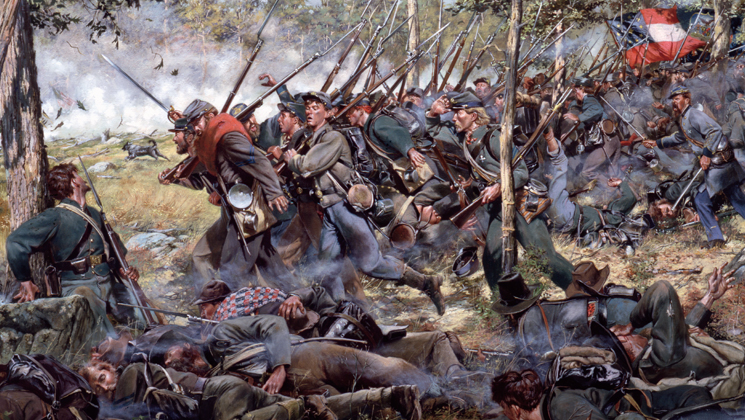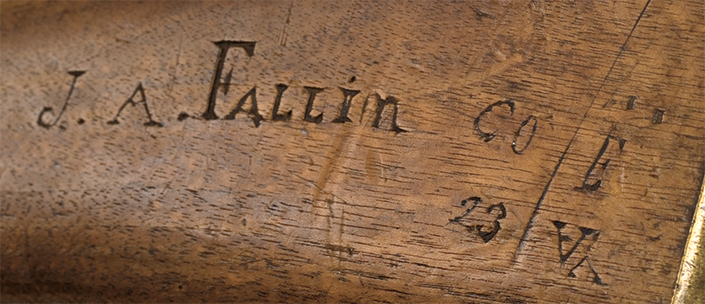
“Band of Brothers” by Don Troiani depicts the men of the 1st Maryland emerging from the woodline on Culp’s Hill at Gettysburg on July 3, 1863. The 1st Maryland was in Gen. Steuart’s brigade with Pvt. John A. Fallin’s unit, the 23rd Virginia. Painting courtesy historicalartprints.com.

This article was first published in American Rifleman, February 2007
The acrid, bitter taste of unburned powder was raw on John A. Fallin’s tongue. Sweat poured down his brow, stinging his eyes, already reddened by the powder smoke enveloping the entire 23rd Virginia. Fallin reached into his cartridge box with his right hand, pulled out another paper cartridge, bit it, held the 500-gr. bullet in his teeth, then poured the powder down the warm, fouled .577" barrel of his Enfield rifle-musket. His non-issue iron ramrod pushed the Minié ball against the fouling and residue within the barrel, and its skirts were engraved by the barrel’s five-groove rifling as he drove the ball home. Replacing his ramrod under the barrel, Fallin reached again to his waist and, with trembling fingers, drew a fresh, fulminate of mercury cap and placed it on the nipple. The gun came to his shoulder, and he took aim again as the 23rd fought to maintain its precarious hold on Culp’s Hill, a nondescript, wooded rise to the southeast of the Lutheran Theological Seminary at Gettysburg. He pulled the trigger and … nothing. The hammer wouldn’t respond. He discarded the useless rifle-musket, and picked up another from a fallen comrade.
Well, that’s how it might have happened to Fallin, a private in the 23rd Virginia Infantry of Steuart’s Brigade, Johnson’s Division, Early’s Corps, Army of Northern Virginia. He was in the fight of his life, as his brigade was being ground down by well-handled Federal artillery and the rifle-musket fire from the 147th Pennsylvania and 5th Ohio. The attempt by the Virginians, North Carolinians and Marylanders of Steuart’s Brigade to break through the Union lines to sever the vital Union artery of the Baltimore Pike was a failure. The bloody fighting around and on Culp’s Hill July 2 and 3—overshadowed in history by Gen. George Pickett’s ill-fated attack on the Union center July 3—would cost Johnson’s Division nearly 2,000 men, a third of its strength.

But why are we bothering with Pvt. Fallin and the likely—but admittedly embellished—account of his experience during the battle for Culp’s Hill? Before Early’s Corps would withdraw on July 4, limping back to Virginia with the rest of Lee’s Army, Fallin’s rifle-musket would be left behind among the carnage and detritus of the most epic battle in American history. It seems that he carved his name and unit, “J. A. Fallin CO E 23 VA,” upside down into the right side of the English walnut buttstock of his Pattern 1853 Enfield. It was done in a folksy serif style, perhaps sometime between June 8, 1863, and July 3, 1863, forever linking him to a specific time, battle and place. His was but one of an estimated 300,000 Pattern 1853, third model Enfields thought to have seen service with Confederate forces during the war.

The Pattern 1853 Rifle-Musket
The pattern was sealed, meaning accepted for British service, for the .577"-cal. muzzleloading, percussion-ignition British Pattern 1853 rifle-musket after trials in 1852. It took advantage of the concept of a conical, hollow-base projectile designed by France’s Capt. Claude Minié in 1849. The projectile’s diameter was slightly smaller than the bore diameter, allowing it to be loaded quickly into a rifled bore. Upon firing, the expanding gas would obturate its hollow base, driving annular rings at the skirt of the bullet into the rifling. Previously, smoothbores were issued to most infantry due to ease and speed of loading, while shorter-barreled, slower-loading rifles were generally reserved for specialty units. As long as a smoothbore infantry musket, but faster loading and with rifled barrels, this new class of arm was dubbed the “rifle-musket”—and it’s combination of long-range accuracy and rate of fire proved deadly on America’s Civil War battlefields.
Pattern 1853s were made in four main variations between 1854 and 1865, generally weighing 8 lbs., 12 ozs., with slightly progressive, five-groove rifling, and measuring 55¼" before being fitted with a 17" triangular socket bayonet that used the front sight as its lug. The ramrod was retained under the barrel by three barrel bands for the full-length infantry model, and collectors generally refer to them as “three-banded” Enfields. There were differences in the design of the barrel bands, ramrods, ramrod retention, sights and manufacturers that are beyond the scope of this article.
When the American Civil War began in 1861, the Pattern 1853 rifle-musket was one of the most advanced designs of its day, and it had been proven on the battlefield by British troops all over the world. It was used extensively by both sides during the War Between The States, as both Northern and Southern agents scoured Europe for arms to equip the rapidly expanding armies of both sides, and Enfields were at the top of every agent’s list.
The Rifle Of “J. A. Fallin”
The rifle is a .577" “commercial”—meaning non-British-government-issue—Pattern 1853, third model made by the Birmingham trade. The barrel and stock both include Birmingham proofmarks appropriate to the crown and a “Tower 1862” marked lockplate that bears no maker’s name or mark. Birmingham commercial, provisional proof and view marks are visible on the barrel’s left.

Changes occurred to Fallin’s gun since it left Birmingham in 1862—who made them, when and under what circumstances are not known. The barrel has been cut down, its outside amateurishly re-crowned about 1½" from the original 38.4" length, and the gun’s overall length has been reduced from 55.4" to 54". It is missing its front barrel band and front sling swivel, as well as the trigger guard-mounted rear sling swivel. The rear sight, too, is missing, but judging from the lockplate date and the barrel bands, it can still be identified as a “third model.” The issue ramrod has been replaced with a straight iron ramrod with a tulip-shaped head, and it actually protrudes beyond the shortened muzzle. The metal’s condition is pretty rough, with more pitting to the barrel assembly than to the hammer and lockplate. And perhaps explaining being left behind by an unwounded soldier on Culp’s Hill, the lock’s mainspring is broken cleanly on its top arm.
“J. A. Fallin CO E 23 VA” as mentioned before is carved into the stock on the right, and a single “F” is carved on the left by the same hand, and there are more Birmingham inspection marks on the stock below the trigger guard tang.

J. A. Fallin’s War
But Fallin (one entry in the 23rd Virginia’s unit roster is under the name “John A. Fallon,” but it is almost certainly the same person) shouldn’t have been at Gettysburg at all. Less than a month before, on June 8, he reenlisted for three more years with the 23rd. He hadn’t been in uniform for nearly two years. Like many young Americans, Fallin had likely signed up in the patriotic fervor that gripped both the North and South following the fall of Fort Sumter. Fallin enlisted with Company E, 23rd Regiment Virginia Volunteer Infantry on May 7, 1861, at Brooklyn, Va., in Halifax County, Capt. William Haynes, commanding. Fallin signed up for one year’s service, but didn’t come close to that. National Archives records indicate he was 5 ft., 9½" tall, with black hair, hazel eyes and a dark complexion. Going by the numbers, it was likely that he was a farmer, as were two-thirds of those in Co. B. The 23rd trained at Camp Lee, Va., and Fallin was listed as sick in July 1861. By August, he was carried on the unit rolls as a deserter.
Desertions seemed to be a habit with Pvt. Fallin. He did it again on Nov. 27, 1863, while he was on guard duty and was placed “in arrest” until February 1864. He was carried again on the unit rolls as a private for two months until he was captured on May 8, 1864, near Spotsylvania, Va. The next stop in his less-than-sterling military career was Fortress Monroe on June 20, 1864. The final listing for Fallin is his discharge from the wretched Federal prison camp at Point Lookout in Maryland on June 12, 1865. Fallin was, well, relatively fortunate, as nearly 4,000 confederate POWs perished at Point Lookout. To be fair to him, Fallin may have been present for the battles of Laurel Hill and Corrick’s Ford in 1861. He is listed as being with the 23rd at Gettysburg, Bealton, Payne’s Farm (likely where he deserted on Nov. 27) and Wilderness. He did, as they say, “see the elephant,” whether he wanted to or not. As his records indicate, he showed a definite proclivity toward the latter.
The Chain
On July 28, 1863, a drummer named David Starry was discharged at Gettysburg from the 165th Regiment of Pennsylvania Drafted Militia, having served the nine months of his enlistment. Starry lived in neighboring Mummasburg, Pa., and picked up some souvenirs from the still-fresh battlefield before returning to his home. These items included “guns, sword, powder horn, bayonet, drums.” One of the guns, a Pattern 1853 Enfield rifle-musket, was picked up “on the slope of Culp’s Hill after the battle.” Starry later was enlisted in Co. B, 21st Pennsylvania Cavalry from Feb. 3, 1864, until he was mustered out on July 8, 1865. His descendent David Starry donated the above items and his July 28, 1865, discharge document to the National Park Service in 1975. All the items are believed to have been with the family for 110 years.
It is rare indeed to find a firearm with provenance to a private soldier during the Civil War. By carving his name in his rifle-musket’s stock, Fallin has helped us bridge a 150-year span of time, making his experience more tangible and real to us today. His breach of discipline was a favor to those of us with an interest in the past. His rifle, slated to be on display next year at the new Gettysburg Visitors Center and Museum, will play a vital role in telling the story of the valor and horror of the Battle of Gettysburg.

Seeing The Fallin Rifle And More
When I came across the rifle, it was in a National Park Service safe at the Gettysburg National Military Park, awaiting a chance to see the light of day. It will, thanks to help from the Gettysburg Foundation, a private, non-profit educational organization that works in partnership with the National Park Service to enhance the preservation and understanding of the heritage and lasting significance of Gettysburg. The Foundation and the NPS are working to care for and conserve the park’s collection of 38,000 Civil War artifacts and 700,000 archival items—including Fallin’s rifle-musket—and to conserve the “Battle of Gettysburg” Cyclorama painting and rehabilitate portions of the battlefield. But the main effort of the Gettysburg Foundation’s Campaign to Preserve Gettysburg is the new Museum and Visitor Center, a 139,000 sq.-ft. facility slated to open to visitors in spring 2008. There will be 11 state-of the-art galleries in the new visitor’s center, including one on Culp’s Hill that will showcase the J. A. Fallin rifle.
For information, contact the Gettysburg Foundation, 1195 Baltimore Pike, Gettysburg, PA 17325; (866) 889-1243; gettysburgfoundation.org or Gettysburg National Military Park, (717) 334-1124 nps.gov/gett.
Mark A. Keefe IV




































